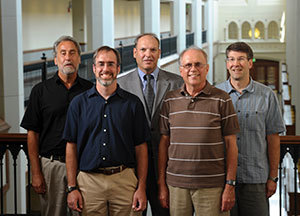 Notre Dame high energy physicists (L to R) Mitch Wayne, Kevin Lannon, Colin Jessop, Randy Ruchti, Mike Hildreth and Nancy Marinelli (not pictured) worked with a number of international collaborators on the search for the Higgs boson
Notre Dame high energy physicists (L to R) Mitch Wayne, Kevin Lannon, Colin Jessop, Randy Ruchti, Mike Hildreth and Nancy Marinelli (not pictured) worked with a number of international collaborators on the search for the Higgs boson
At 6:45 a.m. Tuesday (Oct. 8), the Royal Swedish Academy of Sciences awarded the Nobel Prize in physics to theorists Peter Higgs and Francois Englert to recognize their work developing the theory of what is now known as the Higgs field, which gives elementary particles mass. U.S. scientists played a significant role in advancing the theory and in discovering the particle that proves the existence of the Higgs field, the Higgs boson.
Colin Jessop, professor of physics at the University of Notre Dame, is the leader of the Notre Dame team that works on the Compact Muon Solenoid (CMS) collaboration at CERN. The team’s experiment is one of two Large Hadron Collider (LHC) experiments that shared the Higgs boson discovery. Last year, when the scientists unveiled new data, Jessop said, “All of a sudden I saw a peak that indicated the Higgs, and I fell off my chair, literally. I was walking around in a daze for a day because it was so stunning.”
Notre Dame high-energy physicists Alexey Drozdetskiy, Michael Hildreth, Kevin Lannon, Nancy Marinelli, Randy Ruchti and Mitchell Wayne are also part of the Notre Dame CMS team. “The Notre Dame group has significant leadership roles in a number of key areas on the CMS experiment,” Wayne said, “including building part of the detector, helping operate the detector while data was collected, developing software, analyzing data and working on upgrades to improve the detector’s performance.”
In the 1960s, Higgs and Englertalong with other theorists published papers introducing key concepts in the theory of the Higgs field. In 2012, scientists on the international ATLAS and CMS experiments, performed at the Large Hadron Collider at CERN laboratory in Europe, confirmed this theory when they announced the discovery of the Higgs boson.
The Notre Dame physicists are part of a larger collaboration of nearly 2,000 physicists from U.S. institutions that participate in the CMS and ATLAS experiments, making up about 23 percent of the ATLAS collaboration and 33 percent of CMS at the time of the Higgs discovery. By remotely accessing and analyzing data through high-capacity networks and grids, the U.S. scientists contribute their knowledge and expertise. According to Fermilab, “U.S. scientists provided a significant portion of the intellectual leadership on Higgs analysis teams for both experiments.”
The discovery of the Higgs boson at CERN was the culmination of decades of effort by physicists and engineers around the world, at the LHC as well as the Tevatron accelerator at Fermilab, and the Large Electron Positron accelerator, which once inhabited the tunnel where the LHC resides.
Contact: Colin Jessop, 574-631-5657, cjessop@nd.edu
Originally published by at news.nd.edu on October 08, 2013.